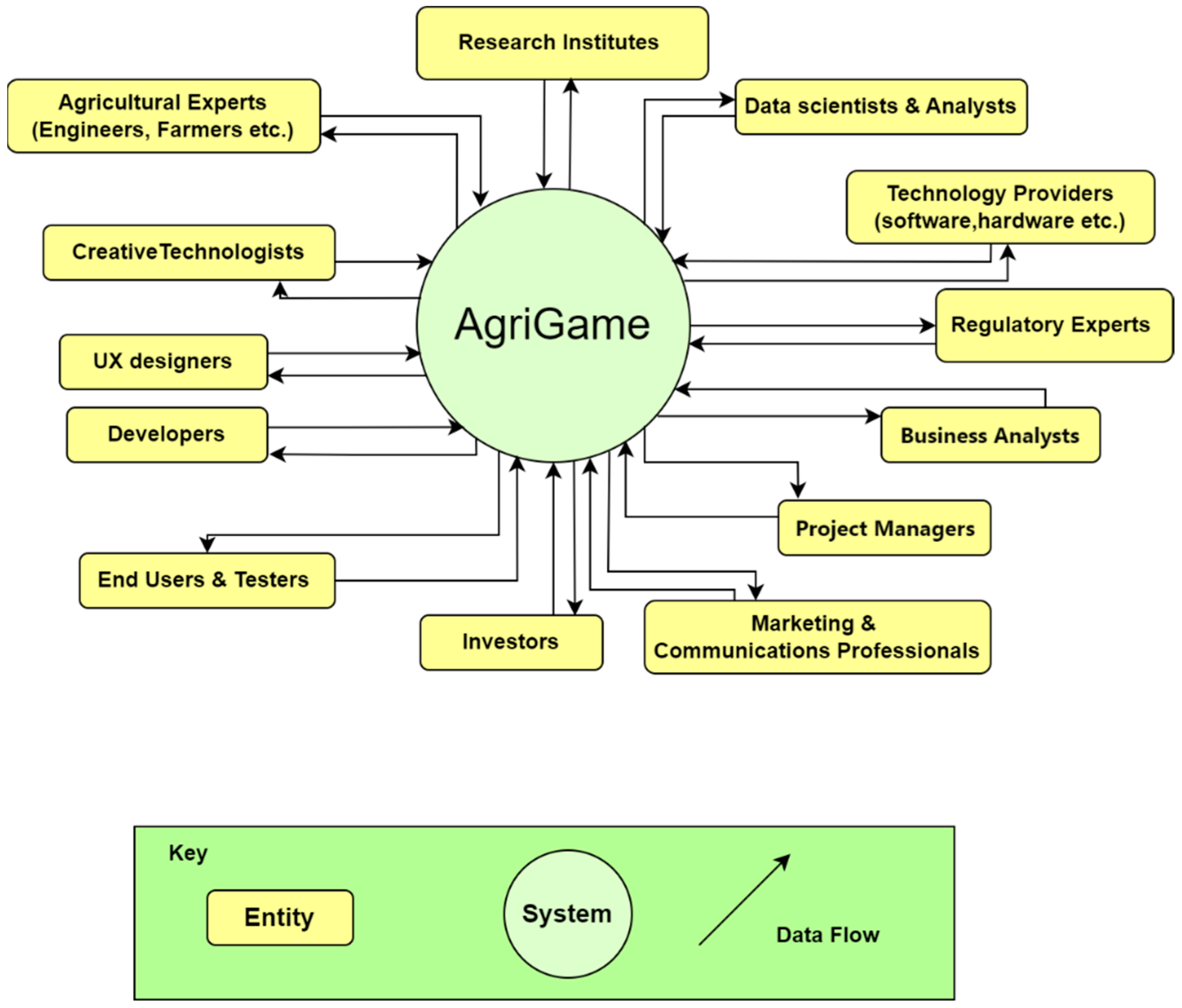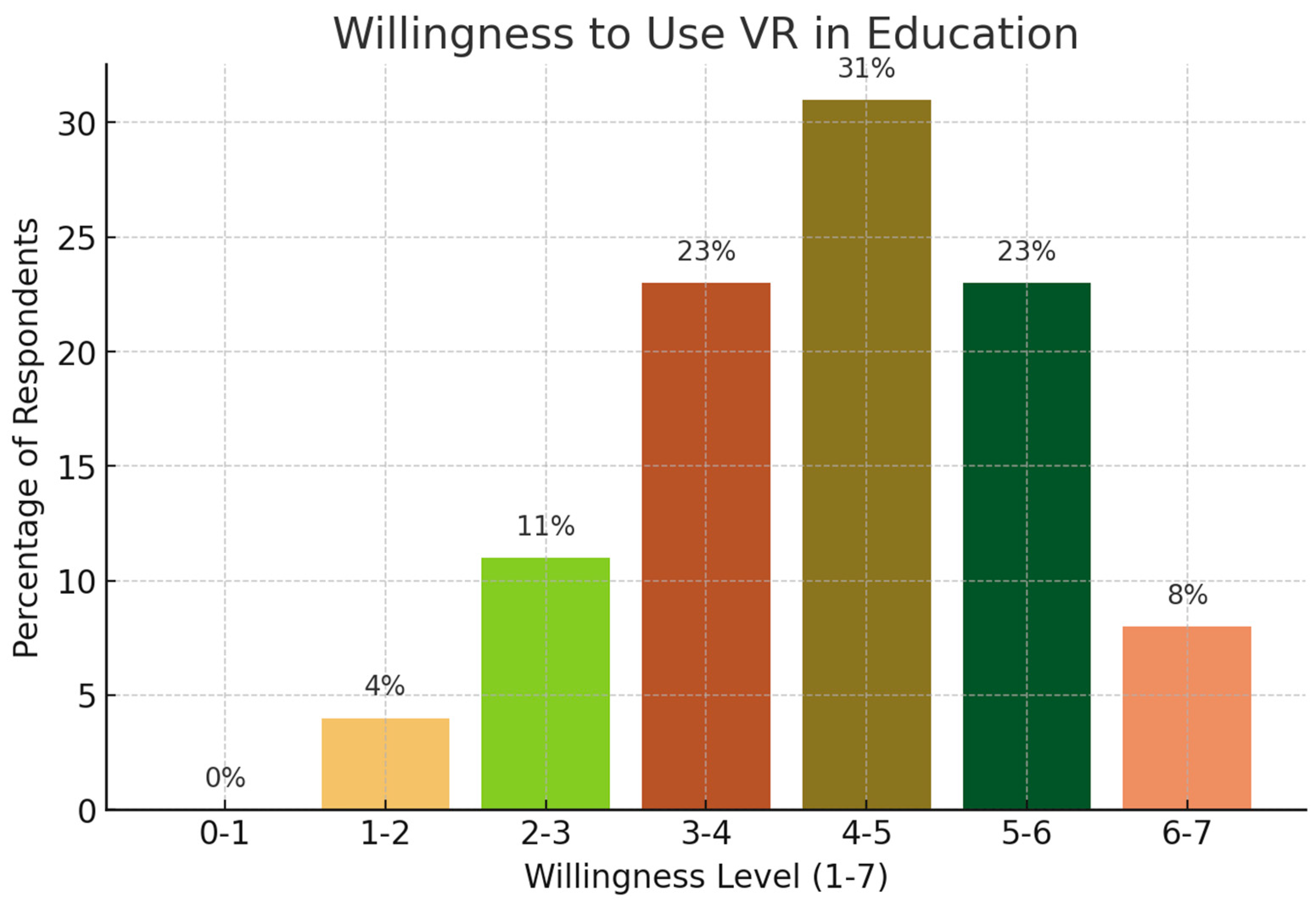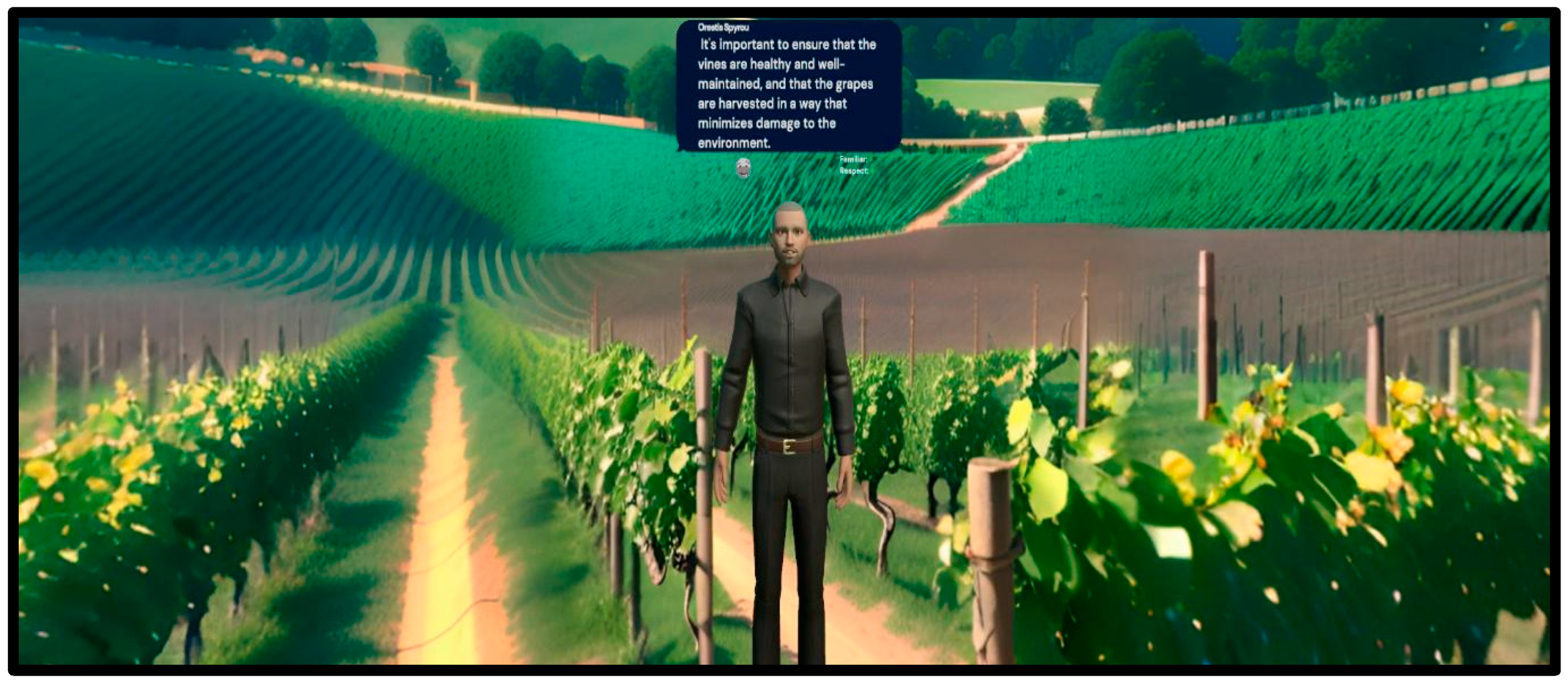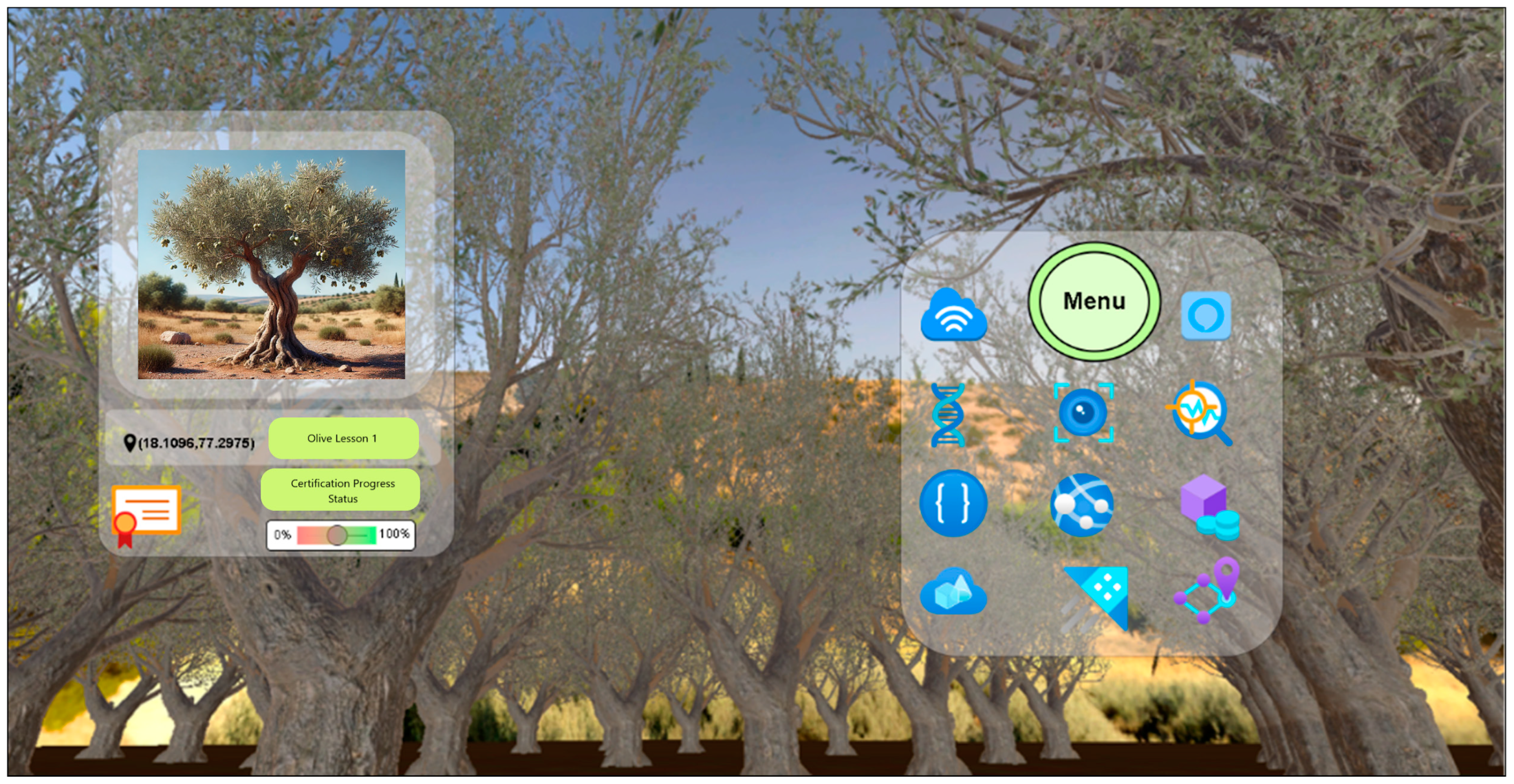Enhancing Education in Agriculture via XR-Based Digital Twins: A Novel Approach for the Next Generation
Abstract
1. Introduction
Literature Review on Digital Twins
2. Materials and Methods
2.1. Survey
2.2. Design Requirements (DR)
- DR1: the serious game architecture must present the interaction between the elements of the physical crops and the corresponding virtualized educational content in the virtual or Mixed Reality environment.
- DR2: the serious game architecture must support the processes and activities regarding the AI-enabled NPCs agents in agricultural education.
- DR3: the serious game architecture must provide information and representation of activities, processes, and features of the designed system.
- DR4: the serious game architecture must provide precise information in the augmented form of the physical and educational counterparts in real-time.
2.3. Context Diagram
2.4. Functional Decomposition View and Architecture Design
2.5. Deployment View
2.6. Research Site and Practice Context
3. Results
3.1. Survey Outcomes
3.2. Proof of Concept
4. Discussion
4.1. Reflection on Hypotheses
4.2. Practical Relevance
4.3. Limitations and Future Work
5. Conclusions
Author Contributions
Funding
Data Availability Statement
Conflicts of Interest
References
- Purcell, W.; Neubauer, T.; Mallinger, K. Digital Twins in Agriculture: Challenges and Opportunities for Environmental Sustainability. Curr. Opin. Environ. Sustain. 2023, 61, 101252. [Google Scholar] [CrossRef]
- Liew, T.W.; Siradj, Y.; Tan, S.-M.; Roedavan, R.; Khan, M.T.I.; Pudjoatmodjo, B. Game-Changer NPCs: Leveling-Up Technology Acceptance and Flow in a Digital Learning Quest. Int. J. Hum.-Comput. Interact. 2024, 1–22. [Google Scholar] [CrossRef]
- Song, Y.; Wu, K.; Ding, J. Developing an Immersive Game-Based Learning Platform with Generative Artificial Intelligence and Virtual Reality Technologies—“LearningverseVR”. Comput. Educ. X Real. 2024, 4, 100069. [Google Scholar] [CrossRef]
- Zhang, L. Application of Artificial Intelligence Technology in Game NPC. In Proceedings of the First International Conference on Science, Engineering and Technology Practices for Sustainable Development, ICSETPSD 2023, Coimbatore, India, 17–18 November 2023; EAI: Coimbatore, India, 2024. [Google Scholar]
- del-Campo-Sanchez, A.; Ballesteros, R.; Hernandez-Lopez, D.; Ortega, J.F.; Moreno, M.A.; on behalf of Agroforestry and Cartography Precision Research Group. Quantifying the Effect of Jacobiasca lybica Pest on Vineyards with UAVs by Combining Geometric and Computer Vision Techniques. PLoS ONE 2019, 14, e0215521. [Google Scholar] [CrossRef] [PubMed]
- Jorge, J.; Vallbé, M.; Soler, J.A. Detection of Irrigation Inhomogeneities in an Olive Grove Using the NDRE Vegetation Index Obtained from UAV Images. Eur. J. Remote Sens. 2019, 52, 169–177. [Google Scholar] [CrossRef]
- Martínez-Peña, R.; Vélez, S.; Vacas, R.; Martín, H.; Álvarez, S. Remote Sensing for Sustainable Pistachio Cultivation and Improved Quality Traits Evaluation through Thermal and Non-Thermal UAV Vegetation Indices. Appl. Sci. 2023, 13, 7716. [Google Scholar] [CrossRef]
- Russell, S.J.; Norvig, P. Artificial Intelligence: A Modern Approach, 3rd ed., Global ed.; Prentice Hall Series in Artificial Intelligence; Pearson: Boston, MA, USA; Columbus, OH, USA; Indianapolis, IN, USA, 2016; ISBN 978-0-13-604259-4. [Google Scholar]
- George, A.S.H.; Fernando, M.; George, A.S.; Baskar, T.; Pandey, D. Metaverse: The Next Stage of Human Culture and the Internet. Int. J. Adv. Res. Trends Eng. Technol. (IJARTET) 2021, 8, 1–10. [Google Scholar] [CrossRef]
- Jagatheesaperumal, S.K.; Ahmad, K.; Al-Fuqaha, A.; Qadir, J. Advancing Education Through Extended Reality and Internet of Everything Enabled Metaverses: Applications, Challenges, and Open Issues. IEEE Trans. Learn. Technol. 2024, 17, 1120–1139. [Google Scholar] [CrossRef]
- Krauss, C.; Bassbouss, L.; Upravitelev, M.; An, T.-S.; Altun, D.; Reray, L.; Balitzki, E.; El Tamimi, T.; Karagülle, M. Opportunities and Challenges in Developing Educational AI-Assistants for the Metaverse. In Adaptive Instructional Systems; Sottilare, R.A., Schwarz, J., Eds.; Lecture Notes in Computer Science; Springer Nature: Cham, Switzerland, 2024; Volume 14727, pp. 219–238. ISBN 978-3-031-60608-3. [Google Scholar]
- Hurst, W.; Spyrou, O.; Krampe, C. The Data Factory: Findings from an Extended Reality-Based Hackathon for Data Science Education. In Proceedings of the 2024 10th International Conference on Virtual Reality (ICVR), Bournemouth, UK, 24–26 July 2024; pp. 85–90. [Google Scholar]
- Slob, N.; Hurst, W.; Van De Zedde, R.; Tekinerdogan, B. Virtual Reality-Based Digital Twins for Greenhouses: A Focus on Human Interaction. Comput. Electron. Agric. 2023, 208, 107815. [Google Scholar] [CrossRef]
- Kong, A.; Feng, Z. Advancing VR Edutainment Design in Blended Learning: Learners’ Views from Wine Classroom. Comput. Educ. X Real. 2024, 5, 100078. [Google Scholar] [CrossRef]
- Hurst, W.; Spyrou, O.; Van Peer, A.F.; Simbelyte, R. DigiFungi: An Education Software for Button Mushrooms. SoftwareX 2025, 29, 101993. [Google Scholar] [CrossRef]
- Bernetti, I.; Borghini, T.; Capecchi, I. Integrating Virtual Reality and Artificial Intelligence in Agricultural Planning: Insights from the V.A.I.F.A.R.M. Application. In Extended Reality; De Paolis, L.T., Arpaia, P., Sacco, M., Eds.; Lecture Notes in Computer Science; Springer Nature: Cham, Switzerland, 2024; Volume 15027, pp. 342–350. ISBN 978-3-031-71706-2. [Google Scholar]
- Greig, J.A.; Colclasure, B.; Rampold, S.; Ruth, T.; Granberry, T. Enhancing Agricultural Education through Virtual Reality: Facilitation, Application, Reflection, and Measurement in the Classroom. Adv. Agric. Dev. 2024, 5, 64–80. [Google Scholar] [CrossRef]
- Hananto, A.L.; Tirta, A.; Herawan, S.G.; Idris, M.; Soudagar, M.E.M.; Djamari, D.W.; Veza, I. Digital Twin and 3D Digital Twin: Concepts, Applications, and Challenges in Industry 4.0 for Digital Twin. Computers 2024, 13, 100. [Google Scholar] [CrossRef]
- Madeira, M.; Porfírio, R.P.; Santos, P.A.; Madeira, R.N. AI-Powered Solution for Plant Disease Detection in Viticulture. Procedia Comput. Sci. 2024, 238, 468–475. [Google Scholar] [CrossRef]
- Marculescu, S.I.; Badea, A.; Teodorescu, R.I.; Begea, M.; Frincu, M.; Barbulescu, I.D. Application of Artificial Intelligence Technologies in Viticulture. Sci. Pap. Ser. Manag. Econ. Eng. Agric. Rural Dev. 2024, 24, 563–578. [Google Scholar]
- Sun, L.; Nie, T.; Chen, Y.; Yin, Z. From Floral Induction to Blooming: The Molecular Mysteries of Flowering in Woody Plants. Int. J. Mol. Sci. 2022, 23, 10959. [Google Scholar] [CrossRef]
- Vance, E.; Loehle, C.; Wigley, T.; Weatherford, P. Scientific Basis for Sustainable Management of Eucalyptus and Populus as Short-Rotation Woody Crops in the U.S. Forests 2014, 5, 901–918. [Google Scholar] [CrossRef]
- Pereyra, G.; Pellegrino, A.; Ferrer, M.; Gaudin, R. How Soil and Climate Variability within a Vineyard Can Affect the Heterogeneity of Grapevine Vigour and Production. OENO One 2023, 57, 297–313. [Google Scholar] [CrossRef]
- Ariza-Sentís, M.; Vélez, S.; Valente, J. BBR: An Open-Source Standard Workflow Based on Biophysical Crop Parameters for Automatic Botrytis Cinerea Assessment in Vineyards. SoftwareX 2023, 24, 101542. [Google Scholar] [CrossRef]
- Testa, R.; Schifani, G.; Rizzo, G.; Migliore, G. Assessing the Economic Profitability of Paulownia as a Biomass Crop in Southern Mediterranean Area. J. Clean. Prod. 2022, 336, 130426. [Google Scholar] [CrossRef]
- Hauk, S.; Gandorfer, M.; Wittkopf, S.; Müller, U.K.; Knoke, T. Ecological Diversification Is Risk Reducing and Economically Profitable—The Case of Biomass Production with Short Rotation Woody Crops in South German Land-Use Portfolios. Biomass Bioenergy 2017, 98, 142–152. [Google Scholar] [CrossRef]
- Funes, I.; Molowny-Horas, R.; Savé, R.; De Herralde, F.; Aranda, X.; Vayreda, J. Carbon Stocks and Changes in Biomass of Mediterranean Woody Crops over a Six-Year Period in NE Spain. Agron. Sustain. Dev. 2022, 42, 98. [Google Scholar] [CrossRef]
- Zhang, Q. Automation in Tree Fruit Production: Principles and Practice; CABI: Wallingford, UK, 2017; ISBN 978-1-78064-850-7. [Google Scholar]
- Tagarakis, A.C.; Benos, L.; Kyriakarakos, G.; Pearson, S.; Sørensen, C.G.; Bochtis, D. Digital Twins in Agriculture and Forestry: A Review. Sensors 2024, 24, 3117. [Google Scholar] [CrossRef] [PubMed]
- Peladarinos, N.; Piromalis, D.; Cheimaras, V.; Tserepas, E.; Munteanu, R.A.; Papageorgas, P. Enhancing Smart Agriculture by Implementing Digital Twins: A Comprehensive Review. Sensors 2023, 23, 7128. [Google Scholar] [CrossRef]
- Angin, P.; Anisi, M.H.; Göksel, F.; Gürsoy, C.; Büyükgülcü, A. AgriLoRa: A Digital Twin Framework for Smart Agriculture. J. Wirel. Mob. Netw. Ubiquitous Comput. Dependable Appl. 2020, 11, 77–96. [Google Scholar] [CrossRef]
- Atallah, M.J.; Blanton, M. (Eds.) Algorithms and Theory of Computation Handbook. General Concepts and Techniques, 2nd ed.; Chapman & Hall/CRC Applied Algorithms and Data Structures Series; Taylor & Francis: Boca Raton, FL, USA, 2009; ISBN 978-1-58488-822-2. [Google Scholar]
- Häring, S.; Folawiyo, S.; Podguzova, M.; Krauß, S.; Stricker, D. Vid2Cuts: A Framework for Enabling AI-Guided Grapevine Pruning. IEEE Access 2024, 12, 5814–5836. [Google Scholar] [CrossRef]
- Ariza-Sentís, M.; Baja, H.; Vélez, S.; Valente, J. Object Detection and Tracking on UAV RGB Videos for Early Extraction of Grape Phenotypic Traits. Comput. Electron. Agric. 2023, 211, 108051. [Google Scholar] [CrossRef]
- Zheng, S.; Gao, P.; Zhang, J.; Ma, Z.; Chen, S. A Precise Grape Yield Prediction Method Based on a Modified DCNN Model. Comput. Electron. Agric. 2024, 225, 109338. [Google Scholar] [CrossRef]
- Vélez, S.; Ariza-Sentís, M.; Valente, J. Mapping the Spatial Variability of Botrytis Bunch Rot Risk in Vineyards Using UAV Multispectral Imagery. Eur. J. Agron. 2023, 142, 126691. [Google Scholar] [CrossRef]
- Mohimont, L.; Alin, F.; Rondeau, M.; Gaveau, N.; Steffenel, L.A. Computer Vision and Deep Learning for Precision Viticulture. Agronomy 2022, 12, 2463. [Google Scholar] [CrossRef]
- Izquierdo-Bueno, I.; Moraga, J.; Cantoral, J.M.; Carbú, M.; Garrido, C.; González-Rodríguez, V.E. Smart Viniculture: Applying AI for Improved Winemaking and Risk Management. Appl. Sci. 2024, 14, 10277. [Google Scholar] [CrossRef]
- Ariyachandra, M.R.M.F.; Wedawatta, G. Digital Twin Smart Cities for Disaster Risk Management: A Review of Evolving Concepts. Sustainability 2023, 15, 11910. [Google Scholar] [CrossRef]
- Harrington, M.C.R.; Bledsoe, Z.; Jones, C.; Miller, J.; Pring, T. Designing a Virtual Arboretum as an Immersive, Multimodal, Interactive, Data Visualization Virtual Field Trip. Multimodal Technol. Interact. 2021, 5, 18. [Google Scholar] [CrossRef]
- Kee, T.; Zhang, H. Digital Experiential Learning for Sustainable Horticulture and Landscape Management Education. Sustainability 2022, 14, 9116. [Google Scholar] [CrossRef]
- Krishnasamy, S.; Smith, M.R.; Naravan, E.; Aziz, A.A.; Hoffman, E.W. Developing Virtual Field Trips for Agriculture. Int. J. Innov. Sci. Math. Educ. 2023, 31, 3–19. [Google Scholar] [CrossRef]
- Purcell, W.; Neubauer, T. Digital Twins in Agriculture: A State-of-the-Art Review. Smart Agric. Technol. 2023, 3, 100094. [Google Scholar] [CrossRef]
- Tardaguila, J.; Stoll, M.; Gutiérrez, S.; Proffitt, T.; Diago, M.P. Smart Applications and Digital Technologies in Viticulture: A Review. Smart Agric. Technol. 2021, 1, 100005. [Google Scholar] [CrossRef]
- Verdouw, C.; Tekinerdogan, B.; Beulens, A.; Wolfert, S. Digital Twins in Smart Farming. Agric. Syst. 2021, 189, 103046. [Google Scholar] [CrossRef]
- Faluomi, V. A Digital Twin Application for Vineyards Sustainable Management. BIO Web Conf. 2023, 68, 01038. [Google Scholar] [CrossRef]
- Alfaisal, R.; Hashim, H.; Azizan, U.H. Empowering the Metaverse in Education: ChatGPT’s Role in Transforming Learning Experiences. In Breaking Barriers with Generative Intelligence. Using GI to Improve Human Education and Well-Being; Basiouni, A., Frasson, C., Eds.; Communications in Computer and Information Science; Springer Nature: Cham, Switzerland, 2024; Volume 2162, pp. 13–31. ISBN 978-3-031-65995-9. [Google Scholar]
- Alnagrat, A.; Che Ismail, R.; Syed Idrus, S.Z.; Abdulhafith Alfaqi, R.M. A Review of Extended Reality (XR) Technologies in the Future of Human Education: Current Trend and Future Opportunity. J. Hum. Centered Technol. 2022, 1, 81–96. [Google Scholar] [CrossRef]
- Khlaif, Z.N.; Mousa, A.; Sanmugam, M. Immersive Extended Reality (XR) Technology in Engineering Education: Opportunities and Challenges. Technol. Knowl. Learn. 2024, 29, 803–826. [Google Scholar] [CrossRef]
- Pregowska, A.; Osial, M.; Gajda, A. What Will the Education of the Future Look like? How Have Metaverse and Extended Reality Affected the Higher Education Systems? Metaverse Basic Appl. Res. 2023, 3, 57. [Google Scholar] [CrossRef]
- Angrisani, L.; D’Arco, M.; De Benedetto, E.; Duraccio, L.; Regio, F.L.; Tedesco, A. A Novel Measurement Method for Performance Assessment of Hands-Free, XR-Based Human-Machine Interfaces. IEEE Sens. J. 2024, 24, 31054–31061. [Google Scholar] [CrossRef]
- Vacalopoulou, A.; Gardelli, V.; Karafyllidis, T.; Liwicki, F.; Mokayed, H.; Papaevripidou, M.; Paraskevopoulos, G.; Stamouli, S.; Katsamanis, A.; Katsouros, V. AI4EDU: An Innovative Conversational AI Assistant for Teaching and Learning. In Proceedings of the INTED2024 Conference, Valencia, Spain, 4–6 March 2024; pp. 7119–7127. [Google Scholar]
- Campitiello, L.; Beatini, V.; Di Tore, S. Non-Player Character Smart in Virtual Learning Environment: Empowering Education Through Artificial Intelligence. In Artificial Intelligence with and for Learning Sciences. Past, Present, and Future Horizons; Palomba, F., Gravino, C., Eds.; Lecture Notes in Computer Science; Springer Nature: Cham, Switzerland, 2024; Volume 14545, pp. 131–137. ISBN 978-3-031-57401-6. [Google Scholar]
- Spyrou, O.; Verdouw, C.; Hurst, W. A Digital Twin Reference Architecture for Pharmaceutical Cannabis Production. Int. J. Comput. Integr. Manuf. 2024, 37, 726–746. [Google Scholar] [CrossRef]
- Inworld: AI-Powered Gameplay. Available online: https://inworld.ai/ (accessed on 26 September 2024).
- Skybox, AI. Available online: https://skybox.blockadelabs.com/ (accessed on 30 September 2024).
- Keller, M. The Science of Grapevines: Anatomy and Physiology, 2nd ed.; Elsevier: Amsterdam, The Netherlands; Academic Press: Boston, MA, USA, 2015; ISBN 978-0-12-419987-3. [Google Scholar]
- African Olive—Download Free 3D Model by Valery.Li. 2021. Available online: https://sketchfab.com/models/9ac2e799b40b4d129074ee04c4e6a57f/embed?autostart=1 (accessed on 26 September 2024).
- Banana Plant—Download Free 3D Model by Evolveduk. 2022. Available online: https://sketchfab.com/models/85695b82c7ba4b3497a663616cc3bf25/embed?autostart=1 (accessed on 26 September 2024).
- Cannabis Sativa Plant|3D Model. Available online: https://www.cgtrader.com/free-3d-models/plant/bush/cannabis-sativa-plant (accessed on 26 September 2024).
- Tropical Mango Trees Free—Download Free 3D Model by Jagobo. 2024. Available online: https://sketchfab.com/models/6997814540f14929bf13cf3828b5dc90/embed?autostart=1 (accessed on 26 September 2024).
- Ahmed, R.K.A.; Alamro, L.; Khlaponin, Y.; Izmailova, O.; Abdulrazzaq, A.Z. Edutainment as a Concept of Education and Entertainment. In Proceedings of the 2024 35th Conference of Open Innovations Association (FRUCT), Tampere, Finland, 24–26 April 2024; pp. 42–50. [Google Scholar]
- Aggarwal, C.C. Neural Networks and Deep Learning: A Textbook; Springer International Publishing: Cham, Switzerland, 2018; ISBN 978-3-319-94462-3. [Google Scholar]
- De Freitas, S.; Liarokapis, F. Serious Games: A New Paradigm for Education? In Serious Games and Edutainment Applications; Ma, M., Oikonomou, A., Jain, L.C., Eds.; Springer: London, UK, 2011; pp. 9–23. ISBN 978-1-4471-2160-2. [Google Scholar]
- Ma, M.; Oikonomou, A.V.; Jain, L.C. Serious Games and Edutainment Applications; Springer: London, UK; New York, NY, USA, 2011; ISBN 978-1-4471-2161-9. [Google Scholar]
- Michael, D.; Chen, S. Serious Games: Games That Educate, Train, and Inform; Course Technology: Mason, OH, USA, 2011; ISBN 978-1-59200-622-9. [Google Scholar]









| Question | Ranking |
|---|---|
| Familiarity with Vineyard Management | Rate from 1 to 7. |
| Interest in Red or White Varieties | 1 indicates white only, 4 both, 7 red only. Rate from 1 to 7. |
| Countries Visited for Vineyards | Netherlands, France, Italy, Spain, Greece, Other. |
| Countries Visited for Vineyards | For the country selected, rate your experience visiting vineyards. 1 means never visited, 7 visited multiple times. Rate from 1 to 7. |
| Familiarity with EU Regulations for Chemical Applications | Rate from 1 to 7. |
| Awareness of Precision Agriculture/Viticulture | Rate from 1 to 7. |
| Suitability of Technology Developments | Rate the suitability of technological developments like AI and drones to improve wine quality and vineyard management. Rate from 1 to 7. |
| Importance of Soil Management | Rate from 1 to 7. |
| Preferred Training Methods for Vineyard Management | Hands-on practice, visual aids, reading materials, and interactive seminars. |
| Knowledge of Climate Change Impact | Rate your knowledge of the impact of climate change on viticulture. Rate from 1 to 7. |
| Interest in Improving Aspects Through Technology | Rate your interest in improving various aspects through technology like pest monitoring and soil/water management. Rate from 1 to 7. |
| Willingness to Use Virtual Reality (VR) Technology | Rate your willingness to use VR technology for training. 1 is not willing, 7 is already used and willing to use more. Rate from 1 to 7. |
| Main Goal in Learning About Vineyard Management | Rate your main goal: starting a vineyard, improving an existing one, or personal interest. 1 means other goals, 7 specific goals mentioned. Rate from 1 to 7. |
| Preferred Medium for Updates and News | Email, social media, websites, and magazines. |
| Approach to Water Management | 1 indicates interest in learning about water-saving techniques, 7 means used advanced irrigation technologies. Rate from 1 to 7. |
| Role of Grape Variety Selection | Rate the role of grape variety selection in your planning. 1 is little involvement, 7 is critical decision factor. Rate from 1 to 7. |
| Interest in Alternative Vine Training Systems | Rate your interest in exploring alternative vine training and trellising systems. Rate from 1 to 7. |
| Quality Assessment Methods | Rate your primary method for assessing the quality of your grapes and wine. 1 means primarily through laboratory testing, 4 is an equal balance between laboratory testing and sensory evaluation, and 7 is primarily by sensory evaluation, taste, and smell. Rate from 1 to 7. |
| Quality Assessment Methods | Rate reliance on external experts separately. 1 is do not rely at all, 7 is rely exclusively on external experts. Rate from 1 to 7. |
| Pest and Disease Management Strategies | Rate your main method for pest and disease management. 1 is exclusively chemical treatments, 4 is a balanced approach including chemical, organic, and IPM methods, and 7 is exclusively organic/natural remedies. Rate from 1 to 7. |
| Staying Informed on Viticulture Trends | Rate how you primarily stay informed about the latest trends and research in viticulture. 1 is primarily through academic journals and conferences, 4 is a mix of academic and practical resources like trade shows and networking, 7 is primarily through online forums and social media Rate from 1 to 7. |
| Climate Change Impact Assessment | Rate your level of concern regarding the impact of climate change on your vineyard in the next 10 years. 1 is not concerned at all, 4 is moderately concerned, 7 is extremely concerned. Rate from 1 to 7. |
| Vineyard Expansion or Diversification Planning | Rate your approach to planning for vineyard expansion or diversification. 1 I have a detailed business plan, 4 I make decisions based on a combination of plans and market trends, 7 I prefer to keep the operation stable and not expand. Rate from 1 to 7. |
| Interest in Collaborative Projects for Innovation | Rate your interest in engaging in collaborative projects with research institutions for vineyard innovation. 1 is not interested, 4 is potentially interested, 7 is very interested. Rate from 1 to 7. |
| Marketing Strategies for Wine and Vineyard | Rate your primary method for marketing your wine and vineyard. 1 is online sales and marketing, 4 is a balanced mix of channels including direct sales and distribution, and 7 is direct sales at the vineyard or local markets. Rate from 1 to 7. |
| Future Perspective on Viticulture and Winemaking | Rate your perspective on the future of viticulture and winemaking in your region. 1 is pessimistic, facing significant challenges, 4 is cautiously optimistic, acknowledging some challenges, 7 is optimistic, foreseeing growth and innovation. Rate from 1 to 7. |
Disclaimer/Publisher’s Note: The statements, opinions and data contained in all publications are solely those of the individual author(s) and contributor(s) and not of MDPI and/or the editor(s). MDPI and/or the editor(s) disclaim responsibility for any injury to people or property resulting from any ideas, methods, instructions or products referred to in the content. |
© 2025 by the authors. Published by MDPI on behalf of the International Institute of Knowledge Innovation and Invention. Licensee MDPI, Basel, Switzerland. This article is an open access article distributed under the terms and conditions of the Creative Commons Attribution (CC BY) license (https://creativecommons.org/licenses/by/4.0/).
Share and Cite
Spyrou, O.; Ariza-Sentís, M.; Vélez, S. Enhancing Education in Agriculture via XR-Based Digital Twins: A Novel Approach for the Next Generation. Appl. Syst. Innov. 2025, 8, 38. https://doi.org/10.3390/asi8020038
Spyrou O, Ariza-Sentís M, Vélez S. Enhancing Education in Agriculture via XR-Based Digital Twins: A Novel Approach for the Next Generation. Applied System Innovation. 2025; 8(2):38. https://doi.org/10.3390/asi8020038
Chicago/Turabian StyleSpyrou, Orestis, Mar Ariza-Sentís, and Sergio Vélez. 2025. "Enhancing Education in Agriculture via XR-Based Digital Twins: A Novel Approach for the Next Generation" Applied System Innovation 8, no. 2: 38. https://doi.org/10.3390/asi8020038
APA StyleSpyrou, O., Ariza-Sentís, M., & Vélez, S. (2025). Enhancing Education in Agriculture via XR-Based Digital Twins: A Novel Approach for the Next Generation. Applied System Innovation, 8(2), 38. https://doi.org/10.3390/asi8020038









